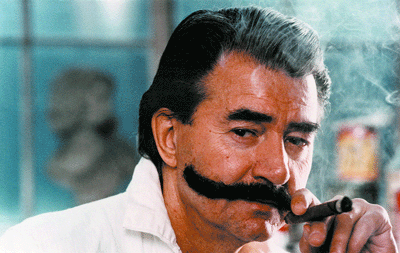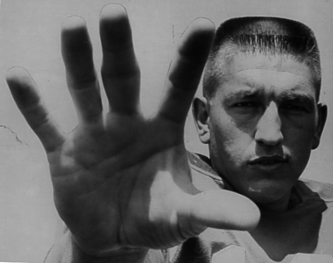
Here is a gem from Tony Kornheiser, a long piece on George Steinbrenner. It originally appeared in the New York Times Magazine on April 9, 1978 at is featured here with the author’s permission.
You’re going to dig this one.
“That Damn Yankee”
By Tony Kornheiser

THE OLD MAN WAS rigid. Dinner was at 5:45 each evening, and it was “Please, sir” and “Thank you, sir” and “May I be excused, sir?” He was a perfectionist. He was an intercollegiate hurdles champion, and he had the kid running hurdles at age 12. If the kid ran three races and won two and finished second in the third, the old man wasn’t completely satisfied; he’d come down from the stands asking, “What the hell happened? How’d you let that guy beat you?” The old man thrived on work. He told the kid, “Always work as hard as, or harder than anyone who works for you.”
The old man owned a shipping company.
He planned that someday the kid would take it over. The kid did even better than that. Now the kid is 47 years old, and he’s chairman of the board of The American Ship Building Company, which is expected to do $180 million worth of sales in 1978. And he’s principal owner of the New York Yankees, the most famous sports franchise in the world, which brings its World Series championship team back to Yankee Stadium this week. And he owns a thoroughbred farm, a hotel and a lot of real estate on the booming west coast of Florida. And he has a piece of the Chicago Bulls basketball team. He has Kinsman Shipping, the family company he bought from his father, and has extensive holdings in land and banking operations. The kid say is a multimillionaire; the multis may well be approaching triple figures.
The kid says it’s lonely at the top, it’s the loneliest place in the world.
But every day he thanks the old man. “You never really appreciated him or liked him as a young person,” he says. “But you appreciated him more as every day of your life went on. I can’t give enough credit to my dad. Anything I ever accomplish I owe to him.”
The father is German. From the father, the kid says he learned to be tough, to drive and succeed, to win; he doesn’t believe in entering a contest just to compete. He believes in keeping score; he doesn’t mess around with No. 2. The mother is Irish. From the mother, the kid says he learned compassion, a feel for the underdog, the desire to help those less fortunate, less blessed. The kid has sent some 75 people through college; he serves on charitable committees; he chairs philanthropic foundations. His closest friends say he’s a soft touch.
But the thesis-antithesis-synthesis doesn’t compute. Something got lost in the mix, an overload of thesis perhaps. The kid is hard on his people. Like the secretary he once fired for failing to get him an airline reservation; he fired her from the airport, over the telephone, when the ticket he went to pick up wasn’t there.
“Clear out your desk,” he said, “you’re through.”
She didn’t budge. Maybe she knew the man.
The next day the kid went to see her in the office.
“I’ve made arrangements to send your son to camp this summer,” he told her; that was how the kid said he was sorry.
“I know I’m tough,” he says. “But I try to make it up to my people in other ways. I don’t like to hurt people. Sometimes I just. . . . Well, I guess I can’t help it.”
George Steinbrenner is charming, generous, philanthropic, well-connected, wealthy, energetic and a delight to be with. He is also imperious, tyrannical, impatient, tough, nasty and almost impossible to work for. If he has to pick a label to hang his psyche on, he picks none of the above.
He picks misunderstood.
“No one has been able to capture the real me, how I feel,” he says. “But I guess it’s tough. It’s hard for me to convey what I really feel. It’s not something I can easily say.”
He lists among his friends such people as Senator Edward Kennedy; Thomas P. O’Neill, better known as Tip, the Speaker of the House of Representatives; Cary Grant, the legend, and Barbara Walters, a close personal friend of Anwar el-Sadat. He lists among his prominent positions, spots on the boards of trustees at the University of Tampa. the Culver Educational Foundation, the University of South Florida Foundation. He is the Florida state chairman of the American Cancer Society. He lists among his accomplishments, assistant varsity football coach at both Northwestern and Purdue, chairman of the Democratic Party fund raising effort in 1969 and 1970, all sorts of charitable work for poverty foundations and sports-for-youth federations and co-producer of such award-winning Broadway shows as “Seesaw” and “Applause.” Oh, and he brought the Yankees back from comatose to champions in five years.
Yet what people remember him for most are his felony conviction for election-campaign fraud in the time of Watergate, and the weekly reports of his threats to fire Billy Martin, the manager of the Yankees, a 49-year-old Fonzie who has been described by John Schulian of The Chicago Sun-Times as “a mouse studying to be a rat.”
George Steinbrenner, who very much would like to be a man of the people, a working-class hero, hasn’t a shot. He takes his satisfactions privately; he gets his beatings publicly.
“I’m the heavy,” he says. “I don’t like it, but I don’t know how to change it.”

“TWO THINGSS ARE important to George,” says a close friend who believes he needs anonymity on this one to stay close. “Two things—winning and power.”
Steinbrenner does not dispute the former; he pleads guilty, with an explanation, to the latter.
“Only if I can use it for good, to help those less fortunate than me,” he says. He is sitting in the restaurant in his Tampa hotel, the Bay Harbor Inn. He puts his elbows on the table and leans forward: This one is coming from the heart.
“I’ll tell you when I really bristle,” he says. “I’ll be sitting at some board meeting, and I’ll hear some big shot say—’Look at those people.’ And you’ll know exactly which people he’s talking about. ‘All they want is their unemployment checks.’ Well, let me tell you something. I’ve been to the South Bronx; how many of those big shots have been to the South Bronx? You gonna tell me that’s all that guy wants in life? No way. . . . If he had the opportunity that I had, God knows he might be a better man than all of us.
“Now look, I’m no crusader, I don’t want it to sound like that. I’m no Robin Hood. I just like to help people, that’s my bag. They call me a flaming liberal; guess I am.”
The little guy, Steinbrenner claims kinship with the little guy. The cabby who has to fight the traffic every day, the bartender, the hotel worker, that’s his cast of characters; he talks about them so often you’d think he did his senior thesis at Williams College on Damon Runyon instead of on the heroines in Thomas Hardy’s novels. His favorite little guy is the one who stops him on the street and thanks him for bringing the Yankees back. He makes it seem there are a legion of little guys out there on the streets of New York, patrolling every comer just waiting to spot him and shake his hand.
“Class,” he says. “What class they have.”
He shrugs.
“I wish I had class like that,” he says. “I wish I had the class to go up to a stranger and thank him for something. I don’t.”
Now it may be a bit hard to swallow that, to fully swallow how a man who likes the feel of a chauffeured limousine can claim this spiritual tie to the little guy. Especially since he’s so hard with his own little people, his secretaries and his office personnel. Especially since he stays at the Hotel Carlyle and wears $40 shirts and sits fifth-row center at the theater, house seats.
But down deep, even if he knows it isn’t readily visible, George Steinbrenner feels like one of the guys. Down deep, he’s at a fraternity party. All his life, through military school and through board meetings, he acted one way and coveted another, and down deep, he wants to be one of the common people, if only for a handshake. Of course his hero is the cabby. The common denominator in New York City is the traffic; Steinbrenner sees it even through the window of his chauffeured limo, he feels it, he sits in it. When you’re stuck on 37th Street, it doesn’t matter if you’re stuck in a cab, or a bus or a limo. You’re all alike. For maybe the only time in his life, he’s down with the people.
“I’ve always kept my emotions inside me,” he says. “They tell me I don’t let myself go, and that’s true. It’s a mark of strength among Germans, you know. . . . it isn’t that frequent that I really enjoy myself. It’s hard to explain, but the feeling I got after winning a World Series wasn’t what I thought it’d be. I remember saying to myself—I wonder why I’m not more excited? But then I saw the happiness I got was seeing happiness in others, and when that cabby comes up to me and says, ‘Thanks for bringing the Yankees back,’ even if it’s just ‘Thanks for spending your money,’ it’s unreal. I feel so good about winning one for New York. This is the greatest city in the world and its people are the greatest people in the world. And I just hope they like me.”
The New York Yankees won the World Series last season.

It should have been some party.
It wasn’t.
All season long the Yankees played “West Side Story” in dugouts and locker rooms throughout the country, and when they closed the curtain—when “Bernardo” Jackson hit his three homers and “Riff” Munson caught his last ball and “Tony” Martin got his contract extended and “Officer Krupke” Steinbrenner made nicey-nice and bought them all championship rings—the cast was too drained to dance. Even with Steinbrenner insisting that months of intramural feuding had forced them to acquire “the mental toughness necessary to win,” the Yankees could only ride their World Series high for one week or so before deflating like a hot-air balloon. The stars of the show needed time to recuperate.

Jackson went to the West Coast, where he apparently took a vow of silence, licked his wounds and rented all the king’s horses and all the king’s men to help put his psyche together again.
Martin, the darling of the fans, seemed to disappear completely. Steinbrenner did the banquet circuit. He made so many speeches and received so many awards that he was to the sports testimonial circuit what Charo is to talk shows.
Only Munson simmered publicly. For someone who rates reporters lower than the lowest, Munson attempted major league manipulation of the press. From his home in Canton, Ohio, he regularly demanded to be traded to the Cleveland Indians, threatened to quit baseball if he wasn’t, and accused Steinbrenner of stiffing him out of some verbal contractual promises. Steinbrenner seemed somewhat amused by Munson’s bluster; he could afford to be. He had Munson’s signature on a contract.
All things considered, not a bad winter at all.
And through it all, the Yankees sold tickets. There was just enough controversy, just enough bad blood to keep them cards and letters coming in. Steinbrenner is theatrical enough to know that controversy sells.
This winter, the Yankees got box office performances by Gabe Paul and Mike Torrez—who departed; Rich Gossage, Rawly Eastwick, Jim Spencer, Andy Messersmith and Al Rosen—who arrived—and Jackson, Munson and Sparky Lyle, the Three Stooges of spring training.
Behind it all—rather, above it all—moving the strings that make the puppets dance, George Steinbrenner’s hands were clearly visible.
Make no mistake, he is the New York Yankees.
Gabe Paul’s departure was at least gracious. He quit as president and general manager and signed on with the Indians. Paul didn’t say anything bad about Steinbrenner publicly, but if he’d had anything good to say he wouldn’t have left. As easily as changing a flat tire, Steinbrenner immediately installed Al Rosen in Paul’s place, as president in charge of explanations.
In Rosen, Steinbrenner has a good and true friend, the devoted ally he never had in Paul. Rosen’s presence is a sure sign that Steinbrenner will be calling all the shots; Steinbrenner believes that winning the championship last season vindicated the moves he made, and this season he will run his team as if it were one of his Great Lakes tankers. This time, if Steinbrenner wants Martin out, no one will be there to block the move; Martin will see Al Rosen opening the exit door as soon as Steinbrenner points to it, and Steinbrenner’s assistant, first base coach Gene Michael, will be walking in before Martin is halfway down the hall.
Torrez’s departure was noisier. He was the Yankees’ best pitcher in the playoff and Series, but Steinbrenner—through Paul—never seriously negotiated to keep him; Torrez was a rent-an-arm, that’s all. After signing as a free agent with Boston, Torrez was quoted as saying, “The Yankees will have just as much trouble next season because Munson and Nettles hate Jackson.” The only thing that surprised Torrez was that more people didn’t know it.
Again, Steinbrenner went the free agent route to improve his Yankees. He signed Rich Gossage, the best available relief pitcher, and Rawly Eastwick, the second-best available relief pitcher. In Gossage and Sparky Lyle, Steinbrenner has the best righty-lefty bullpen duo in baseball. If all this fast relief works out, Steinbrenner could put Alka-Seltzer out of business. Gossage’s presence infuriated Lyle enough to ask to be traded to a team where he’ll pitch more and earn more. Consider that Lyle was the best pitcher in the American League last season, and now he wants out. Could you ask for a better controversy?
Steinbrenner made one cosmetic attempt to trade Lyle, but found it easy to turn down a deal sending Lyle and Chris Chambliss to Texas for Claudell Washington and Paul Lindblad.

The next day Steinbrenner told the press that Lyle wasn’t going anywhere. Then, just to let Lyle stew in his own juices, Steinbrenner said, “Like I told Sparky, ‘How much market value is there for a 34-year-old reliever?'” It may not be great public relations, but it made a striking headline.
Oh, and Munson’s still here.
“You really didn’t think he’d quit?” Steinbrenner asks, doing a strut with his voice.
Some people take refuge in being the underdog; with his money, Steinbrenner is forced to be the overdog. The mistake is in thinking that the overdog won’t bite. New York City is making that mistake in its recent complaint about the size of the bone that Steinbrenner has buried in his tenant’s contract at Yankee Stadium with the city. Suddenly, after the Yankees won the World Series and made a $12 million profit in 1977, the city started crying about the contract it had negotiated with the Yankees even before Steinbrenner purchased the team in 1973. It seems that the contract—assumed by Steinbrenner, but signed by CBS, the previous Yankee owner—allows the Yankees to deduct maintenance costs before paying tenant taxes. That clause—perhaps it should be called “the insanity clause” in honor of the city lawyers who agreed to it—allowed the Yankees to pay only $150,000 to the city last year, less even than Ron Guidry makes for pitching for the Yankees. Now the city wants to renegotiate. You could hardly blame Steinbrenner for telling the city exactly where to file that request. Especially considering that the Mets’ contract at Shea Stadium with the city is even more of a sweetheart deal. Steinbrenner’s overdog philosophy is that he is being picked on just because he’s winning; As The Worm Turns in The Big Apple, on your soap opera digest.
“I’ll meet with the Mayor,” Steinbrenner says. “He’s the leader of the city.”
A simple one-on-one. Dueling egos. Bet on George.

IT IS EARLY IN spring training and Steinbrenner is sitting comfortably in the Yankee dugout in Fort Lauderdale watching his players work out. As usual, he is wearing blue. Normalcy, such as it is, is alive and well on the Yankees.
Martin is out of Steinbrenner’s sight; Munson is avoiding reporters; Jackson is entertaining them. There is the sound of baseballs hitting bats, then skimming the grass, then slapping into gloves. Players are making fun of other players. Steinbrenner seems pleased.
He seems to be holding court from his dugout seat, greeting his players with a pleasant one-liner, then sending them on their way with a smile. This is his element, the throne room of spring training. From here he dispenses his medicines, always a first name, always a smile, always a gentle prodding to improve oneself. This will be a crucial season, he says. If it were breakfast time, he would insist this would be a crucial breakfast.
“Lou,” he says to outfielder Lou Piniella, “that hat’s too small.”
Piniella is wearing a size 3 cap on a size 7 head. “I need some sun, George,” Piniella says.
“Oh, you Spaniards all tan quick,” Steinbrenner says.
Surely, this must be the most fun of all for Steinbrenner. The jock chatter. He is in his dugout and all’s right with the world.
“Things are going just great,” he says, “Sure, we have problems, but every team has problems. The thing is that this year it will be so much easier. The players understand each other and they understand what Billy and I want. They went through hell last year, but they all were toughened by the experience.”
On another side of the field, Martin is answering questions about spring training and the upcoming season. Each time he is asked about Lyle, about Jackson-Munson, about Jackson-Martin, even about Steinbrenner-Martin, his answer is basically the same.
“Everything is beautiful,” Martin is saying. It sounds robotomized, something out of the closing scenes of “One Flew Over the Cuckoo’s Nest.”
It will be the Yankees’ slogan this year.
Everything Is Beautiful.
At least until the first blowup of the season, which ought to happen no later than next week, and possibly as soon as today.

The press corps that covers the Yankees is leery of Steinbrenner. It sees his charm, appreciates his availability and distrusts his sincerity. One reporter calls Steinbrenner, “the Queen of Hearts—he’s always one second away from shouting, ‘Off with their heads.'” Reporters think he starts controversies for the sheer sake of action. They think he’s very theatrical with them and very demeaning with his employees.
Worst of all, they think he lies.
More than anything else, Steinbrenner resents being called a liar. Specifics, he demands specifics. It has been alleged that the night before the final papers were to be signed—Steinbrenner instructed Joe Garagiola Jr.—then Yankee counsel, to write some clauses in Reggie Jackson’s contract in 1977, to deliberately attempt to substantially alter the oral agreement.
“An outright lie,” says Steinbrenner. “Boy, that bums me. I want you to call Steve Kaye, in Oakland, he’s Reggie’s attorney, and ask him about his dealings with me. Wait, here’s his private number. Call him.”
The call was made, and Kaye characterized the allegation as “ridiculous.” Kaye said Steinbrenner was “completely honorable in our dealings. Yes, there were some slight adjustments we made in the final contract, but that’s normal. George was eminently fair with us.”
It has been suggested that Steinbrenner, in 1976, had his employees’ office telephones tapped.
“Never,” says Steinbrenner. “We thought that our phones might have been bugged, so we had the telephone company sweep my office to see—just my office; they told us the lines were clean.”
New York Telephone Company records show that in 1976 the Yankees reported trouble with their phone lines. An inspection revealed no tapping, but a circuit problem; anyone calling in could patch into even the most private conversations. It was fixed.
Most of the allegations against Steinbrenner are groundless, apparently carried on the wings of distrust.
Others are not.
Steinbrenner did lie about the nature of an injury to Mickey Klutts, a shortstop; Steinbrenner concealed that Klutts had a broken hand, telling the press he had only a sprained thumb. He did so to prevent the Yankees—who were trying to trade for Bucky Dent—from being put in a compromising position on the deal.
“It will never happen again,” said Steinbrenner at that time. Last month, he said he had to do it to prevent another team from taking advantage of his Yankees.
Another alleged lie concerns Thurman Munson. It is alleged—publicly by Munson—that Steinbrenner reneged on certain verbal promises to Munson after making them to induce him to sign his contract in 1977. Munson has let people know that Steinbrenner promised him that he would be the highest paid Yankee, except for Catfish Hunter but including Reggie Jackson. The story that Steinbrenner put out is that the promise was based on annual salary, not total value of contract including deferred compensation.
“Go ask Thurman about it,” says Steinbrenner.
Munson will not comment.
“It’s just a misunderstanding,” says Steinbrenner. “Misunderstandings happen in business; they are not lies.”
Semantics, perhaps. But crucial to Steinbrenner’s character. He does not lie, he says. He demands loyalty, and he gives loyalty. He demands hard work, and he gives hard work. Uppermost is the belief in the system.
This leads to a personal theory about George Steinbrenner.
It is the Blue Spotlight Theory.

It holds that newspapers are printed in black and white, and black is a hard and fast color. George Steinbrenner does not photograph well in black and white. Blue is his favorite color, his best color. It is said that under a soft blue light a Phyllis Diller can look like a Phyllis George.
Steinbrenner carries a metaphorical soft blue spotlight around with him, and plugs it in and shines it on himself when the questions get hotter than he cares for. Half the time he shines it on himself on the record. Half the time he shines it on himself off the record, not for print. This system gives him the upper hand; he controls the rules. His sides of the stories are fascinating. They are also unprintable. The reporter deals in black and white; Steinbrenner speaks fluent blue.
“He’s a man of his word,” says Catfish Hunter, whose guaranteed contract makes him immune from retaliation. “Even though a lot of times you have to get it in writing to make sure of it.”

GEORGE STEINBRENNER STUDIED voice for three years and was the president of the Williams Glee Club; he attends the opera and ballet; he knows the difference between arabesque and changement de pieds, and how many people in baseball, he wants to know, know that?
Yet his favorite television program is “The Gong Show.” Obviously, a man of great width.
Most of his players couldn’t care less that Steinbrenner is familiar with the fifth position in ballet; they like his money.
He is generous with it. He pays his players as much as any team in baseball. He buys them free suits, gives them bonuses at All Star time, picks up their tabs in certain hotels and restaurants, notably in the Theatrical in Cleveland, gives them cab fare home so their wives won’t have to pick them up when the Yankee charter lands late at night. Steinbrenner’s players go only one way—first class. He rewards excellence just as he punishes incompetence; if you put out, he puts up.
The crown jewel in Steinbrenner’s holdings is the Yankees. Although Steinbrenner says his favorite businesses are still his shipping companies it’s because he has a sentimental tie with the industry that goes back 100 years in his family. It is the Yankees that afford him the most visibility and celebrity.
“The Yankees are a great, great vehicle,” Steinbrenner says.
His eyes twinkle.

He is now the majority owner of the team. In 1973, when he put together the team that purchased the team from CBS, Steinbrenner owned some 20 percent of the ball club. But in the past five years he has personally bought out such original partners as Jess Bell, Marvin Warner—now United States Ambassador to Switzerland—Ed Ginsberg, Sheldon Guren, Nelson Bunker Hunt, Edward Greeenwald and Thomas W. Evans, increasing his ownership to some 55 percent of the team. The Yankees are now valued at about $25 million, a 150 percent increase over the sale price in 1973.
“George is an empire builder,” says Patrick Shields, a close friend. “The only trouble is that he was born a little too late. Most of the world has already been parceled out.”
The Yankees are much more than just another company to Steinbrenner, they are an image and an obsession. He claims to still “well up” every time he sees Gary Cooper portray Lou Gehrig on film. Steinbrenner, who was born on the Fourth of July and who considers himself a patriot above all, truly believes that the Yankees are important to this country, that if they are strong, then the country is strong, that if they are neat and clean, then they serve as shining examples to the youth of this country. You cannot shake him from that tree.
“The Yankees are apple pie and hot dogs,” he says.
“You know that he bought the rights to ‘George M.’ when the Broadway show lost millions,” says Tip O’Neill. “You know that George put that show in every city in the country, not so much to make money, but to get people waving the flag again. He did it right after Vietnam. That tell you something about George?”
Steinbrenner wears Bill Blass shirts, primarily because Blass is an American designer. Steinbrenner’s favorite writers are Melville, James Fenimore Cooper and John Greenleaf Whittier. Americans all. He even refuses to buy foreign automobiles.
“I have a Rolls Royce,” says Reggie Jackson. This is obvious. It’s a silver and blue Corniche, the kind that retails for almost $80,000; it doesn’t wholesale. One day Jackson discovered some nicks on the passenger side and treated the discovery as if he had been told he had leukemia. If he didn’t want dents, he should have bought an anti-personnel tank.

“So George and I are having dinner one night,” Jackson says, “and I say to him, ‘Boss, when are you gonna get a real car? When are you gonna quit that Cad you been driving and get a Rolls? C’mon big man, get the kind of car you rate.'”
“‘I believe in America,” George says.
“‘So?”
“‘So, if it’s not made with American Steel, I don’t buy it.'”
Al Rosen says that Steinbrenner would have been comfortable with men like John D. Rockefeller and Jay Gould, empire builders. History has called these men “ruthless.” Rosen does not like the sound of that word; he prefers tough, but fair. Steinbrenner never minds when people call him tough, but fair. He believes in winning. (“He’s the kind of owner,” says Piniella, “who likes a 163-game lead with 162 games left.” The baseball season, you should know, lasts 162 games.) He believes that if you win, it means you have done things right. Some people say that sounds like “The end justifies the means,” they say it sounds Machiavellian. Steinbrenner could share a chocolate sundae with Mr. Machiavelli.
Growing up in Cleveland, Steinbrenner was the kind of guy who was in bed by 10:30 every night of the year except on New Year’s Eve, when he was in by 11. But if he was a rooster in Cleveland, he is an owl in New York, and he has made the transition easily, remarkably easily, as if he had always known that he was born to run on the other side of midnight. If there is a term that applies to those people born west of the Hudson River who are convinced that they belong on Fifth Avenue, it might be “Neo-Yorker.”
In the history of this country, there are, arguably, a number of American myths that define who we are as a people. One is the Frontier. One is the New England town meeting. One is New Orleans jazz. Another is the New York Yankees.
The Yankees were up for sale and down in the standings. Steinbrenner saw himself as the person with cash, drive and vision enough to restore them to their proper position; more importantly, he recognized what that position was. Now, here was the Yankee club, a fallen idol in need of restoration. Like him, an inheritance to be claimed. Like him, a proud history. Like him, a need to be No. 1.

He came in shooting his mouth off about how he would make the Yankees world champions in five years–and he delivered. “Look, when I came here four years ago,” says Piniella, “all you ever heard about was the Mets. Now all you hear is the Yankees. That’s George.” He came in walking the walk and talking the talk of a native New Yorker, the ones he’d seen all those years on the Johnny Carson show. He seemed to be a boulevardier, but they were long gone since the days of Jimmy Walker, so now we’d call him a beautiful person. Think of the in-spots in New York—”21,” Le Club, Elaine’s, Jimmy Weston’s, Mike Manuche’s, P.J. Clarke’s—the spots where the sporting crowd, the literary crowd and the political crowd overlap, then look for George, the man in blue at the head of the featured table.
It is almost a secret that he is married and has four children, and that home is in Tampa. They are all shielded from the public eye that Steinbrenner seems to crave so much that you’d think he was born with an asbestos cornea. In Tampa and Cleveland he is still the same old George he always was. It is only in New York that he jumps from his base at the Carlyle to the opera, to the theater, to the ballet, to the ball park, as if he had stuffed chili peppers in his Gucci loafers.
Steinbrenner is very big on crowds. He seems to need them and feed off them. He has his walking around guys; the total effect is that of a permanent floating crap game. Some people who know him suggest that he is scared of the intimacy of one-on-one personal relationships, and, if it’s valid, that could be because he is, at his core, an insecure man, a man who has been able to win at almost everything he competed in but who never really found happiness in the winning. Look closely at George Steinbrenner and you’ll see that he is always running that third hurdles race and listening for his father’s approval. Look closely and you’ll see that his football background and his military school background and his business background have taught him that winning isn’t everything, it’s the only thing. Look closely and you’ll see a winner—even if he doesn’t. The shame of it is that he’s never satisfied. The one thing he didn’t count on when he counted on New York was that he couldn’t run away from himself.

There are some players who surmise that Steinbrenner, jocko that he is, bought the Yankees to be a Yankee. There is something to that. Steinbrenner likes to wander the locker room, although he does it less than before. The lesson was learned last season on a bus ride in Texas. The bus driver was hopelessly lost, driving the bus in circles around the Dallas airport. Almost two hours went by; the players were annoyed. As usual.
“I guess we’re just going out to do another favor for Steinbrenner’s daughter,” someone yelled out. In spring training Steinbrenner had the Yankees play an exhibition game at the University of North Carolina, where Steinbrenner’s oldest daughter attends college.
Steinbrenner heard the comment and foam formed on his lips.
“Who said that?” he demanded.
” Who said that?” the veins stood in his neck like chicken bones.
Graig Nettles—”cowering,” Steinbrenner says—said he did.
“Well, don’t you ever say another goddamned thing about my daughter again,” Steinbrenner said, making fists with his voice.
The next morning, at breakfast, Gene Michael, a former player and now an assistant to Steinbrenner, took his boss aside and told him if he wanted to ride the bus with the players, he’d have to learn to accept a certain amount of locker room humor—the kind of humor where a man with acne is called “Pizza Face.”
“George,” Michael said, “they wouldn’t kid you if they didn’t at least like you.”
“Gene,” Steinbrenner said,” I shouldn’t have been on the bus.”

Some of the tenseness still lingers. Steinbrenner recognizes it, and tries to laugh it off; he’s got a terrific sense of humor really. Much of it with himself as the target.
Just the other week, driving from the Fort Lauderdale airport to his hotel, Steinbrenner noticed a hang glider soaring over the beach. Turning to the driver, Steinbrenner said, “You wouldn’t get me up on one of those for all the money in the world.”
“It’s just a ride,” the man said. “The guy is being towed by a boat. It’s nothing scary.”
“Don’t kid me,” Steinbrenner said. “I’ll tell you what. I bet you could get every guy on the team to put up $1,000 each just to get me up there, and then one of them would stand there with a rifle and—bang—shoot the glider.”
Steinbrenner howled with laughter.

FLORIDA DOWNS IS A small thoroughbred track near Tampa. Steinbrenner has a filly running in the ninth, and he wants to watch her, and he brings guests, a young couple from Long Island on vacation in Florida. He knows the filly is over her head in a stakes race, but he’s hoping she’ll place in the top three; he plans to retire her and make her a brood mare, and placing in a stakes race will up the ante.
Before pulling out, Steinbrenner combs his hair. His hair is scientifically exceptional; it never ruffles in the wind. Some people have accused him of wearing a toupee, but he doesn’t. He just has obedient hair. Perhaps he has threatened to fire it. After starting the car, Steinbrenner puts in a cassette of disco music. He loves disco music. The story is told that Steinbrenner once berated the Yankee Stadium electrician for testing out the sound system—at 11 A.M. with no one in the park, mind you—with a record that was not a disco record. Some stories are too good to try to confirm.
The track has a country fair feel. Hialeah it ain’t. In the infield there is what appears to be a swamp. Steinbrenner moves to the Turf Club. None of the little people on his way recognize him although he is wearing his championship ring with its diamond-studded “NY” logo the size of Venezuela. Are there no cabbies in West Florida?
Steinbrenner has been in horses for about seven years. Prior to that he didn’t know a hoof from a flank. But he is a quick study. Now he’s expert on bloodlines and configurations. He starts talking about forelocks and fetlocks and possibly warlocks. He has the seventh doped in minutes. It is, he says, a question of breeding. He likes 7-4-2 in the perfecta; the sires impress him.
“What do you like?” he asks the Long Island girl.
“I bet numbers and colors.”
“And what do you like?” Steinbrenner asks her husband.
“I bet names.”
“Names?”
“Yeah. I like First of Dawn.”
First of Dawn went wire-to-wire in mud, paying $25.60.
“Unreal,” Steinbrenner said.
“Unreal.”

Next race, the wife liked Purple Britches, and the husband liked a horse trained by someone named A. Fink. Steinbrenner bet the quinella, that the horses would finish one-two.
“The true test of a champion is to repeat,” he told the husband.
“Get a bushel basket for the winnings,” the husband said.
Purple Britches ran first, followed by Beta Broker, trained by A. Fink. The quinella paid $34.
On his way to the paddock. Steinbrenner passed a frozen custard stand. Ice cream, especially chocolate, is his weakness. He tells people that he loses control of his car within one mile of a Dairy Queen. “They go there on their own,” he says. “I can’t stop them. Automatic steering.” Steinbrenner carries about 12 pounds more than he ought to around his belt line.
They decide to get some ice cream after Steinbrenner’s horse finishes. In the program morning line she’s 20-1; she may not finish for days.
Over the public address system comes the announcement. “In the ninth race, Jenny’s Lady, three pounds over. Jenny’s Lady!’
Steinbrenner winces. His blue eyes ice over; it appears to be smoke coming out of his left ear.
“That’s no good,” he says.
Jenny’s Lady is his horse. She’s overmatched anyway. She’s a come-from-behind horse, and the track is muddy so she might not even want to run. Now, instead of carrying 119 pounds, she has to carry 122 because her jockey is three pounds over. Steinbrenner thinks it will cost him at least one length. He slams his program at a wall.
“Trainer’s fault. Sure, the boy should come in at weight, but it’s the trainer’s fault for not knowing about it.”
There is a Steinbrenner story that has him firing a trainer after an incident at this very track when the trainer told Steinbrenner that his horse would win, and it finished last. Steinbrenner didn’t like being lied to. If the horse is a mutt, he wants it straight.
The jocks come out to claim their mounts. The one wearing the blue and brown of Kinsman Stud Farm looks as if he’d just got off a police lineup.
“That yours, George?”
“He’s the one. I wanted him because he’s a veteran, and I thought this little girl needed a veteran.”
Steinbrenner glared at the little man. “He’ll never ride for me again.”
Jenny’s Lady went off at 60-1 and deserved it. She finished next to last.
On the way out of the track Steinbrenner passed the frozen custard stand. It was closed.

“I HAVE SHORTCOMINGS too, but I am the boss,” Steinbrenner says.
Reggie Jackson certifies it by calling Steinbrenner “Boss.” He wouldn’t call Steinbrenner “Boss” unless he meant it respectfully and affectionately.
“A wheeler-dealer,” Jackson says, smiling. They like each other. Steinbrenner stood with Jackson last season when Billy Martin tried to humiliate him; Steinbrenner identifies with his player. They share the pursuit of excellence and celebrity. They understand that controversy fills the seats. “That’s what it’s all about,” as Steinbrenner says. They also share a spirit; neither was born in New York City, and neither flourished until getting here. New York is a spotlight city. Each discovered that he liked it.
“An action guy, he needs a lot of action going to keep his interest. He bores easily. He likes his chauffeured limos and his night life; he likes to roll the dice,” Jackson says. He pauses. “I’ll say this, and I won’t apologize for it later—if George Steinbrenner were a ballplayer, he’d be like Reggie Jackson.”
Negatives are suggested; Jackson listens attentively as the list is recited: Steinbrenner goes through secretaries the way some men go through martinis. Steinbrenner sets people up to take a fall for him. Steinbrenner drives a hard bargain, and you wouldn’t want to get on his bad side because he never forgets and he can do to a man in public what some people wouldn’t even dream of doing in private.
Ruthless? No, Jackson says. A good businessman. Acute.
“But no matter what’s said about the man,” Jackson says, “George Steinbrenner brought pride back to this city. He foot the tab. That was his neck stuck all the way out there, not mine, not yours. So, it’s his party.”

Pep talks are part of the party. Steinbrenner believes in pep talks. “Once you’ve heard the first one or two, you can almost sleep through the others,” says Catfish Hunter. “He means well, but they always sound the same. It’s always how we’re embarrassing ourselves and embarrassing New York and baseball and the country. George tells us how he was a football coach, and how he was in locker rooms before we were born. It’s always, ‘I, this’ and ‘I, that.’ The way he talks, you think he thinks he could do a better job than the manager. He tells us that he never makes a mistake, and that we can’t either; he tells us that if he made mistakes, he wouldn’t be as successful in business as he is—hell, even he makes mistakes.”
At least two.
At least one monster.
The first was in Cleveland, in the early 60’s, when he went down the chute with the Cleveland Pipers of the old American Basketball League. The team won, but it didn’t draw. Steinbrenner, turning on that little blue spotlight, says that he was 10 years ahead of his time with pro basketball in Cleveland. He lost about $400,000 and was advised to go into bankruptcy, but didn’t. What he did do proved to be the single smartest business decision he ever made. Instead of taking his partners down with him, he paid off all nine of them and then worked to pay off every creditor the Pipers owed. That made his reputation as a businessman of his word.
“Now,” says Walter Knapp, president of Tampa Ship Repair, a subsidiary of American Ship Building, “George’s word is so good that if he said he needed $10 million to make a deal tomorrow, he’d have 10 guys with a million each lined up tonight.”
But Watergate was a loss, a total loss.

He tries shining the blue spotlight on it, but he doesn’t have enough amps.
Although he was the Democrats’ chief fund-raiser in 1969 and ’70, he played footsie with the Committee to Re-Elect the President in 1972. Steinbrenner’s businesses weren’t growing the way he felt they should; the Internal Revenue Service was doing an audit; Government contracts were being stalled. Steinbrenner reasoned that he was being targeted by Nixon’s men, so he decided it would be good business to do some business with the Republicans. He agreed to give $75,000 of his own money to the Nixon people, and he decided to give $25,000 of other people’s money to the Nixon people. What he did was give his employees bonuses, then instruct them to give those bonuses to the Nixon people.
“My lawyers told me it was perfectly legal. They gave me written and oral permission to do it,” Steinbrenner says.
It wasn’t legal.

One of his lawyers was John Melcher Jr. Melcher has since resigned from the bar as a result of “this mess,” as he calls it. Watergate, he says, was “a nightmare.” He says, “George wants someone to blame this thing on.”
Why did Steinbrenner get involved with the Committee to Re-Elect the President? “I wanted to do things that I thought were needed for the Great Lakes, for Cleveland, and I knew if I had some pop, or whatever you want to call it, I could do the things that I knew had to be done for the people, and that’s the truth,” Steinbrenner says.
On April 5, 1974—opening day of the baseball season—Steinbrenner was indicted on 14 counts of illegal actions pertaining to election fraud.
On April 19, he pleaded not guilty.
On Aug. 23, some time after retaining the legal counsel of Edward Bennett Williams, Steinbrenner pleaded guilty to one count of illegal campaign contributions and one count of aiding and abetting obstruction of an investigation. Through plea bargaining, Williams succeeded in getting the other counts dismissed. Steinbrenner paid a $15,000 fine for his felony conviction, and to this day he cannot vote.
Most of the other corporate heads caught in the Watergate slime got off with misdemeanors. Steinbrenner got the felony, he thinks, because he didn’t come in voluntarily. One might disagree. One might reason that he drew the felony because he obstructed the investigation. Although Steinbrenner insists that he never asked his employees to lie about their part in the contributions—maybe he didn’t; maybe they were just so scared that when he “remembered” what happened in one way, they found it easy to “remember” it the same way—there is sworn testimony before the Senate Watergate Committee that Steinbrenner called his employees together and urged them to misrepresent what really happened. That sworn testimony was given by his employees.
“Under extreme pressure by the prosecutors.” says Steinbrenner, who doesn’t like to talk about what he calls “the election incident.”
Further, before sentencing, Tom McBride, the assistant special prosecutor—”an honorable man,” says Steinbrenner—told the Federal judge that Steinbrenner knowingly and continually urged his employees to lie even after receiving advice from counsel that such action was illegal.
“I never asked them to lie,” Steinbrenner says to a reporter just before he tells the reporter to turn off his tape recorder. Steinbrenner’s version, the soft blue spotlighted version, is off the record.

Steinbrenner has come to cast himself in the good soldier perspective. That posture suggests that he took the heat for his friends, presumably some high-level political friends who couldn’t afford to have their soiled linen laundered in open court. Some prominent Democrats—some very prominent Democrats—will agree. Not that Steinbrenner has forgotten his conviction. On the contrary, he wears it tattooed on his psyche just as he wears his World Championship ring on his finger. He does not need to be reminded that he is a felon.

To be sure, there are those who say he look the heat only after running out of people to lay it off on, and that a corporate head’s most deadly sin is not having enough lay-off guys when the seat heats.
Perhaps what happened to Steinbrenner is that he followed his own personal business law until it conflicted with the rule of law—and then followed it some more. The rules of law are, arguably, constructed to blunt the “laws” of business. Steinbrenner has his legal advice neatly arranged in signed affidavits. He also has his conviction. It is written in black and while, which are not his shades, not at all.

ANOTHER PERSONAL THEORY: Numbers Count, Make It Big.
Like many businessmen, Steinbrenner speaks in numbers. He uses them to make points, which are numbers too.
He is fond of saying that 50 people per week stop him on the street and thank him for bringing the Yankees back. He is fond of saying that the Yankees were the first American League club in the 76-year history or the league to draw two million in home attendance and another two million in road attendance. He tells you that while the Yankees receive only one-26th of the revenue from major league baseball properties—balls, balls, T-shirts, etc.—the Yankees account for 17 percent of all sales. That live televised baseball has been bought by the Japanese this year under the stipulation that 16 of the 22 televised games feature the New York Yankees.
This strategy, when abused, leads to the indefensible posture that if you pour three quarts of béarnaise sauce on a quarter pounder, you will think you are eating chateau briand.
George Steinbrenner is a generous man. He has, in fact, done more things, spent more money, given more time to youth sports projects in New York City than any other sports executive in this city.
But it is a quality of Steinbrenner’s that he goes for superlatives where ordinarys will suffice. Every game is crucial. Every series is crucial. Good things are super or unreal. Catch him at a bad time, and he says it is positively the worst time.
“If something goes wrong,” says an employee, “you never get the chance to give the full explanation of why it went went wrong because you’re stupid. And what’s worse is that he says it in front of other people.”
In a recent week, Steinbrenner was in Tampa on a Monday, in Fort Lauderdale on Tuesday, in Cincinnati on Wednesday, in Boston on Thursday, in Miami on Friday and in New York on Sunday. On Saturday, even Steinbrenner doesn’t remember where he was.
“It’s such a rat race for the guy,” says Catfish Hunter. “He can’t even take a vacation. People like that never have any fun.”

IN HIS OFFICE AT Yankee Stadium, Steinbrenner has a large, round wooden table. His chair is the only one with a high back, like a throne. He’ll call a meeting and his staff will give reports. Brief reports. Steinbrenner has no patience with rambling.
“O.K., that’s enough,” he’ll say. “That’s a red flag area. Get me a memo on it. Next.”
Red-flag areas produce rules: Employees are to be at their desks for 30 minutes after a night game, back at work at 9:30 a.m.; employees must sign out for lunch and leave a telephone number.
“He treats his employees like they’re in elementary school,” a former employee says. “He treated Gabe Paul like a secretary.”
Gabe Paul, the former Yankee president, a man Steinbrenner described as “brilliant” last Oct. 17, is with the Cleveland Indians now.
The story of Gabe Paul is an example of how rough Steinbrenner can be. On the record, Steinbrenner praised him, gave him credit for putting the Yankees together, credit for keeping relative peace among Jackson, Munson, Martin and even Steinbrenner. Off the record, Steinbrenner told reporters that Paul’s health was failing, that he didn’t understand what Steinbrenner was trying to do with the team, that he did not really put the team together, that he—Steinbrenner—assisted on all trades, that he—Steinbrenner—kept the peace. Steinbrenner dangled Paul’s authority all season long, insisting that Paul would make the final decision on the hiring or firing of Martin, thus insuring a lay-off guy if needed. There were times when Paul was seen crying in his office from the strain that Steinbrenner put on him.
“I don’t mind Gabe leaving with his image intact,” Steinbrenner said this spring in Fort Lauderdale. “But he was in baseball for 40 years, 25 as a general manager, and did he ever win a pennant before? You think he made all those moves with this team himself? You think all of a sudden he got brilliant?”
When Steinbrenner was reminded that “brilliant” was the precise word he had used not six months before to describe Paul, he changed course and flipped on something soft and blue.
“A brilliant baseball man, yes,” Steinbrenner said. “But he was getting old. Look, let him have his image if he wants it. I won’t say anything bad about Gabe. Maybe I was too hard on him. Maybe I hurt him. If I did, I’m sorry.”

Shoot first, apologize later.
Steinbrenner calls this tendency a dent in his armor.
What’s next for Steinbrenner?
Some of his close friends say he wants a Kentucky Derby winner real bad, that he’ll spend progressively more time with his horses, and back off the Yankees. But Steinbrenner devotes only about 25 percent of his time now to the Yankees, and he is unlikely to give up his main source of celebrity. The Yankees are still “a challenge” to him. Rich people use that word, “challenge.” Little guys, when they switch jobs, say, from the phone company to selling insurance, say they did it for “money.”
George Steinbrenner wants to be the most powerful man in baseball. Not the commissioner, mind you, just the most powerful. An example of that want lies in what he said when he planned to raise his minor league players’ salaries high above the minimum allowed, just to provide them with what he called “a decent standard of living, to show them we care.”
“The rule says you’re paying too much,” his farm director told Steinbrenner.
“Screw the rule.” Steinbrenner said. “We’ll make a new rule.”
One last story:

Twice in the last five minutes Steinbrenner had picked up the phone in his spring training office expecting to hear Ted Turner’s voice on the other end. Twice, the line had gone dead.
Steinbrenner buzzed the secretary in charge of telephones.
The secretary, mindful—ever mindful—that Steinbrenner is not a patient man, apologized.
He was waiting for Turner because Turner owns the Atlanta Braves, and Steinbrenner wanted Turner as a signatory on a letter he was drafting, a letter supporting the Commissioner of Baseball. In recent weeks, a small group of owners—notably Ray Kroc of San Diego and Brad Corbett of Texas—were trying to get Bowie Kuhn ousted as commissioner. Steinbrenner considered the move “ill-conceived.”
There arc two significant groups of baseball owners. One is the Young Turks. This coterie has been formed primarily by Steinbrenner and includes Ruly Carpenter of Philadelphia, Bob Lurie of San Francisco, Bud Selig of Milwaukee, Peter O’Malley of Los Angeles, Clark Griffith of Minnesota and Dan Galbreath of Pittsburgh. Significantly, O’Malley, Griffith and Galbreath are sons of owners who might logically be called the Old Turks. The Young Turks claim to stand for constructive change in baseball; the Old Turks basically stand for the National Anthem. Included among the Old Turks are such owners as Gussie Busch or St. Louis, M. Donald Grant of the Mets and Jerry Hoffberger of Baltimore. With Tom Yawkey of Boston and Phil Wrigley of Chicago now deceased, the Old Turks have lost significant power. They depend on such maverick owners as Bill Veeck of the While Sox, Brad Corbett of Texas and Ray Kroc of San Diego to blunt the Steinbrenner group, but Steinbrenner & Company seem to hold the trump cards now. Steinbrenner and Turner, who once tampered with another team’s player prior to a free agent draft, are the only owners Kuhn has ever suspended. Neither figures to support him; Kuhn would be well advised to bring a food taster should he go to dinner with Steinbrenner and Turner.
“Mr. Steinbrenner,” the secretary said, “Mr. Turner on 22.”
With considerable skepticism, Steinbrenner pushed the button.
“Ted, old guy, how are you?”
There followed a remarkable conversation, which clearly demonstrated Steinbrenner’s fund-raising capability. Within 10 minutes, Steinbrenner had persuaded Turner to become a signatory. He assured Turner that the letter in no way supported Kuhn personally, but supported the Office of Commissioner, which should be safe from attack. He congratulated Turner on his America’s Cup triumph, throwing in a few “supers” and a few “unreals” as he marveled at Turner’s ability to turn a yawner of a boat race into front page news worldwide. He reminded Turner he had lobbied for his reinstatement to full ownership privileges at the recent major league meetings. He told Turner that he was the kind of owner baseball needed; he said the Young Turks of baseball ownership really liked him and he could count on their continued support. He even told Turner that late at night, at his home in Tampa, he can get Turner’s Atlanta television station.
“Those are great ads you’ve got on for the Braves. Ted, I swear I saw them. Last night, when you were running that movie. ‘Mister Roberts’ with Jimmy Cagney. I saw it. Honest to God.”
By the end of their conversation Turner would have made out a blank check payable to Kuhn and had Steinbrenner fill in the amount.
“We needed him on that letter, you know,” Steinbrenner said to his visitor after the call. “The other guys knew it, but they were afraid to ask for his support. Not me.”
Steinbrenner leaned back and smiled. In the back of the room, a soft, blue spotlight was shining.






































































































